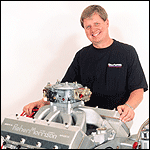By David Reher, Reher-Morrison Racing Engines
“Behind every successful New Age engine is someone with a laptop computer.”
I didn’t actually start drag racing during the age of the dinosaurs, but sometimes it feels like I did.
The smart phone in my pocket has exponentially more memory and power than the computer that took Apollo 11 to the moon – back around the time when Buddy Morrison and I were starting to build racing engines in the back room of Mansfield Auto Supply. But even this old dog can still learn new tricks, and I’m warming up to the notion of laptop racing.
We still have a solid core of customers who like traditional engines with carburetors and distributors. But we also have a growing base of New School racers and performance enthusiasts who are comfortable with electronic fuel injection, digital ignition systems, and the popular “power adders” – nitrous oxide, centrifugal superchargers, and high-tech turbos. I’ve learned that behind every successful New Age engine is someone with a laptop computer.
Back in the day, when someone asked for engine tuning advice, I could tell him, “Put No. 78 jets in the carburetor.” Now we look up fuel injection tables with duty cycles, pulse widths, injector durations, and so forth – optimum values that have to be determined in 250 rpm increments. That’s when a laptop tuner really earns his pay.
Fortunately, I have a partner who is literally and figuratively up to speed on computer-controlled engines. Since Bruce Allen hung up his racing helmet, he’s built several spectacular ’60s automobiles with 21st century powertrains. His latest creation is an award-winning 1962 Corvette “restomod” with a fabricated tubular frame and an LS-series engine. Bruce knows how important it is that all those electrons inside a Powertrain Control Module are programmed properly, and he works with guys who can make those electrons do their bidding. Consequently we’re making huge strides in our LS engine and cylinder head development programs.
The fact is that we use computers in every aspect of our business, from machining parts and CNC porting cylinder heads to dyno testing engines, tracking parts inventory, and paying our employees. Computers have become indispensible in everyday life. But without the right hardware, the latest and greatest software is only a collection of ones and zeroes.
It’s the same way with engines in the Digital Age. You can have the most advanced EFI software on the planet, the fastest processor, and the baddest power adders in the catalog, but if the basic hardware – the short-block and cylinder heads – aren’t up to the the job, all of that high-tech electronic firepower is useless. It’s often said that an internal combustion engine is an air pump – and in my experience, the best air pump with the best tune-up usually wins the race. Fuel molecules don’t know or care whether they were sucked through a carburetor venturi or shot from a fuel injection nozzle. The goal in competition engine building has always been the same: burn as much fuel as possible, quickly and efficiently.
Parts matter. Some guys will bolt a high-boost pulley kit onto a supercharged street engine, pulverize the stock pistons, and then wonder what went wrong. A weekend warrior puts a 300-horsepower shot of nitrous on a marginal motor and then drives over the connecting rods in third gear. The glossy ads don’t tell you that your beloved engine will go “Kaboom!” when it’s stressed beyond the limits of its components. That’s why you need to rely on the real-world experience of an established engine builder to tell you what’s going to live, and what’s going to blow up. There is no shortage of Internet Experts, but there is no substitute for establishing a relationship with a knowledgeable and experienced engine shop.
Just as computers have evolved rapidly, so have racing engines. When I started drag racing, we used production blocks, cranks, and cylinder heads, and tried to turn them into racing parts. Thanks to advances in materials, metallurgy, and machining, the aftermarket and factory pieces that are available today are light years ahead of what we used only a few years ago. The cylinder heads on many of our sportsman engines are better than the heads that won Pro Stock championships!
It doesn’t matter whether an engine breathes through a Stromberg 97 carburetor or a state-of-the-art boosted induction system – it still must have the right stuff to survive. The more power an engine makes, the more cylinder pressure it produces. More cylinder pressure means higher loads and increased stress on components – pistons, rings, wrist pins, bearings, cylinder walls, crankshaft, and so on. No software program can overcome the performance limitations of junk pistons and frail connecting rods. When horsepower rises, the weakest link is always revealed.
Restrictive cylinder heads and lazy camshaft profiles can’t produce the airflow that’s necessary for maximum power. The same painstaking development that produced power gains in Old School engines still applies to modern motors. The induction system and valvetrain must still move air, fuel, and exhaust gases quickly and efficiently.
As a lifelong “engine guy,” I know that a strong foundation – the hardware – is still as important as software in this Digital Age.

